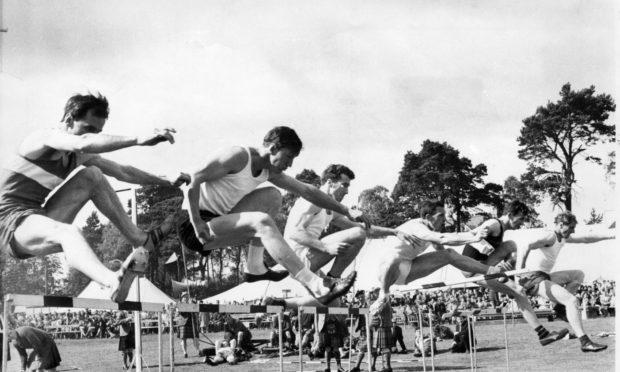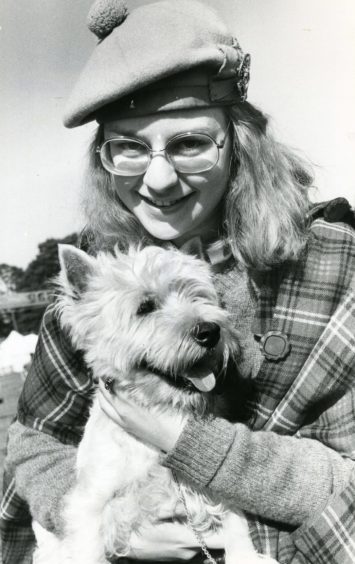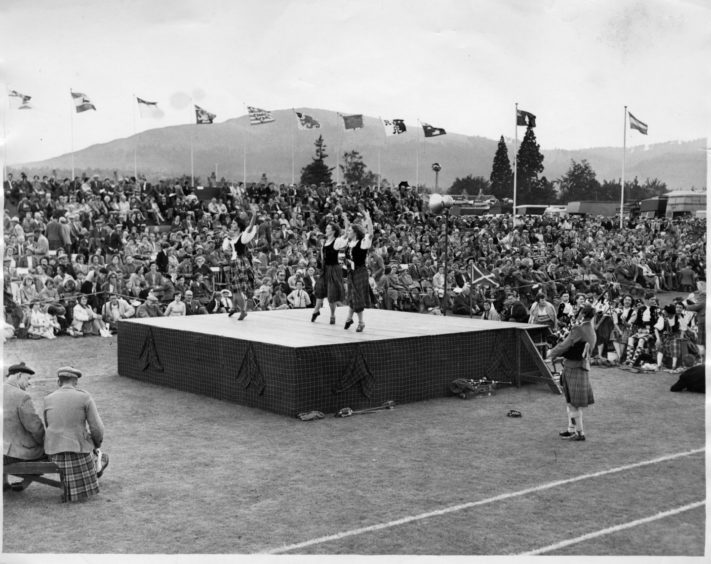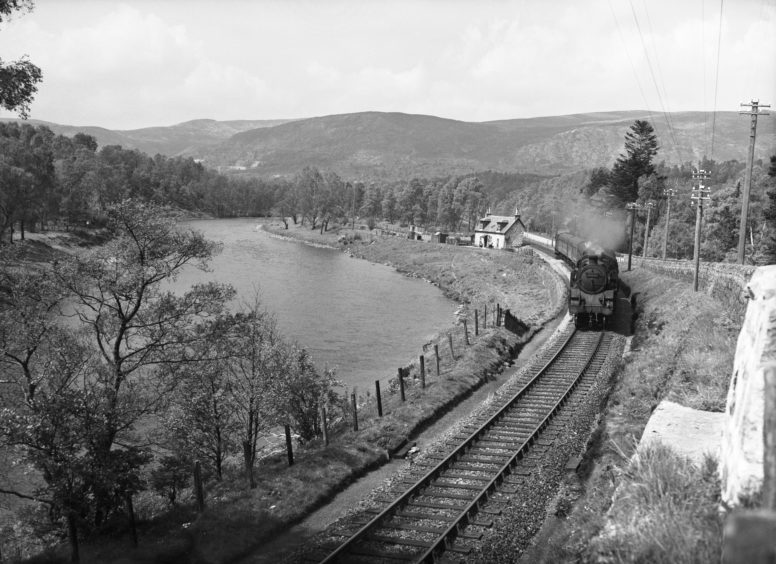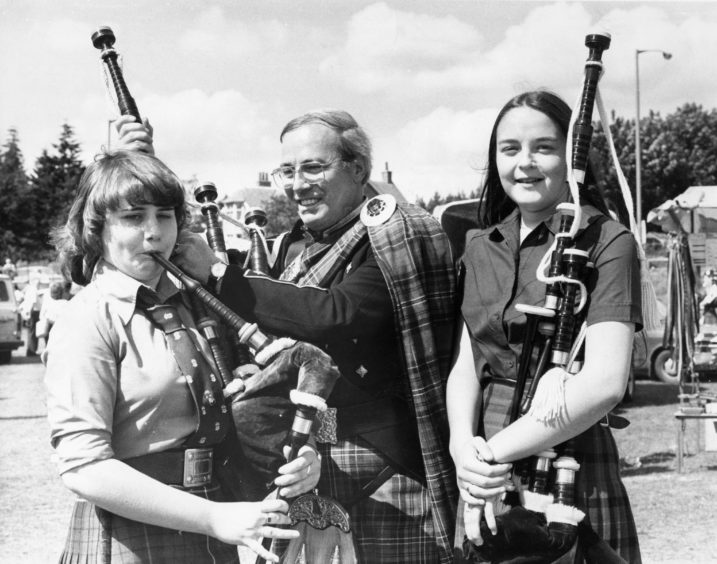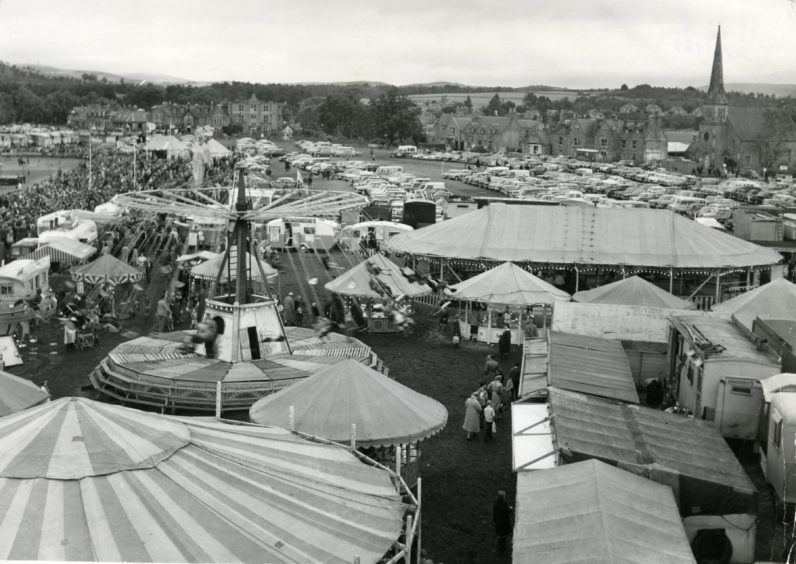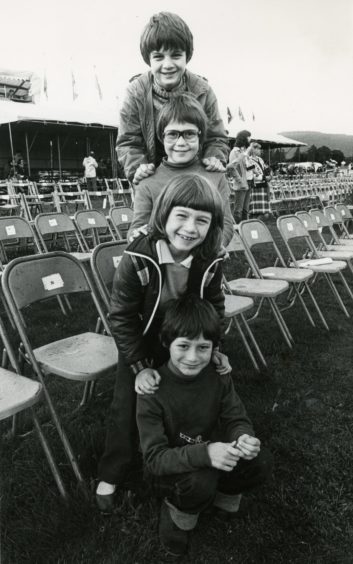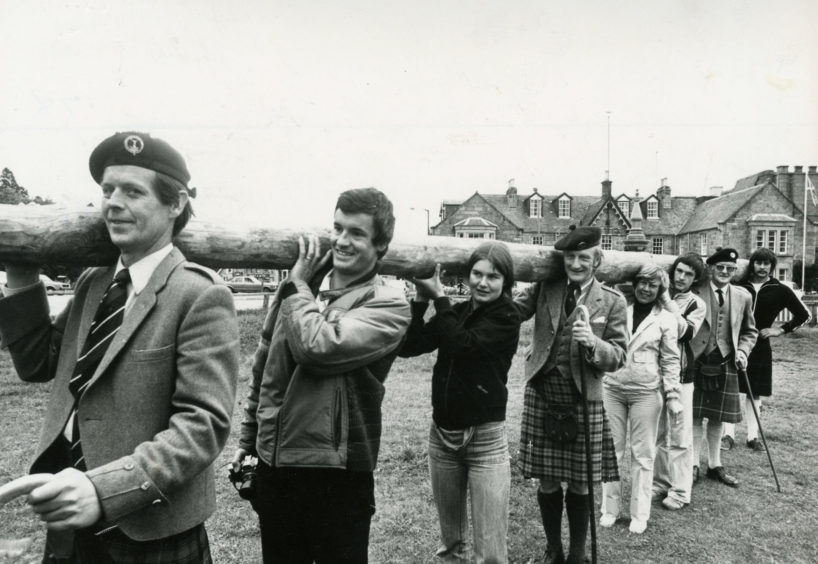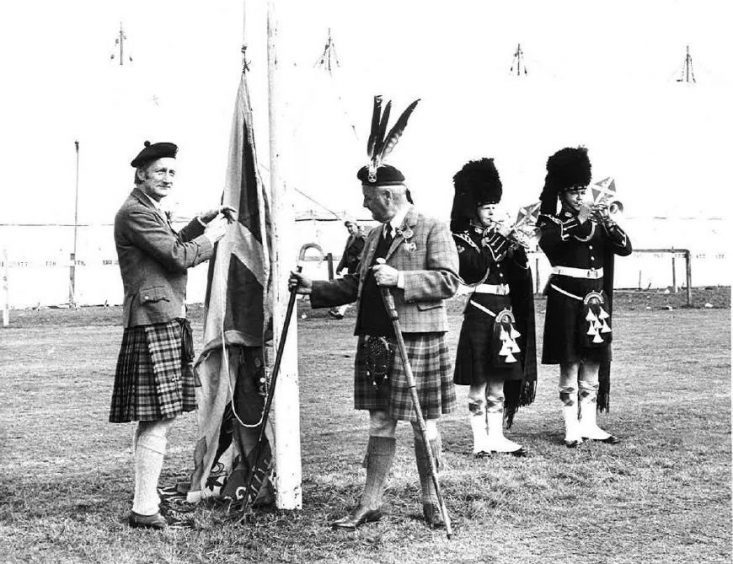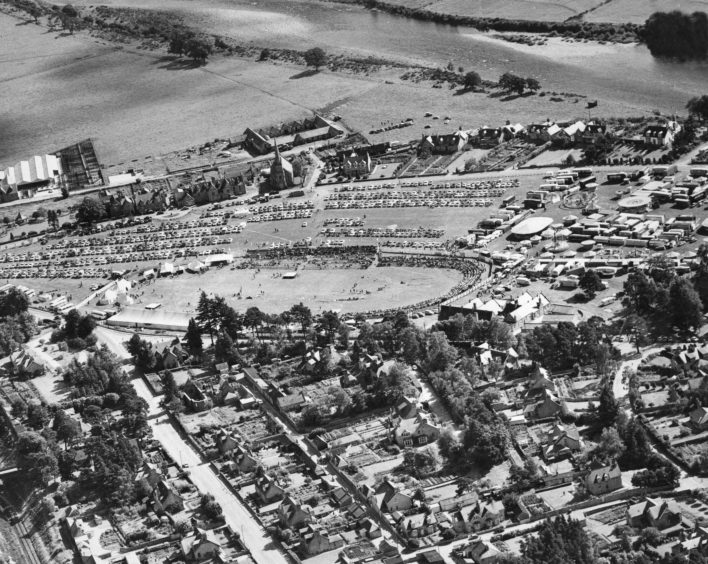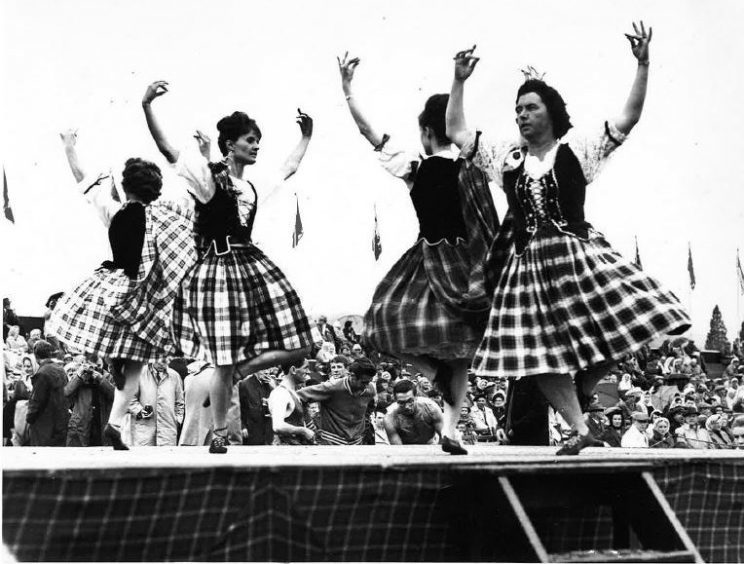It’s an event which was launched when Queen Victoria was on the throne and members of the Royal family have been distinctly amused whenever they have attended the Aboyne Games.
During the last 150-plus years, the festival has gained an international reputation, been the subject of some striking artworks and was even featured in a Channel 5 documentary exploring its connections to the former Deeside railway network.
Unanimous wish
Sadly, although lockdown restrictions are easing, Games officials have confirmed the event will not be held this year for only the second time since the Second World War.
But, while it’s a blow, two online music competitions are being arranged – one for pipers, following the format of the 2020 contest, and another for fiddler players.
And the organisers are determined to return with a flourish in 2022.
The Games were a success from the outset
The first meeting of the inhabitants of Aboyne and the surrounding area was held on Saturday July 27 1867 in the Huntly Arms Hotel in Aboyne, “where a unanimous wish was expressed to get up an Athletic Games on the Market Stance in Aboyne”.
A committee was formed to organise proceedings, which included world-renowned athlete Donald Dinnie – the man whose frame appeared on the original Irn Bru bottles – and his younger brother Lubin, who were born near Aboyne.
Five weeks later, on Saturday August 31, a crowd of “several thousand spectators, of all classes, and all out for a holiday, surrounded the large enclosure on the muir” to watch the first Aboyne Highland Games.
The proceedings were held under the patronage of a number of local landowners, including the 11th Marquis of Huntly, Charles Gordon, who became chieftain of the games and one of the great trailblazers of the initiative.
Indeed, it was a role he held for 70 years until his death in 1937, at which time his son Douglas Charles Gordon, the 12th Marquis of Huntly took over the role.
Formidable reputation
He served as chieftain for 50 years which means that these two redoubtable fellows maintained the momentum of the Games for an astonishing 120 years.
And upon his death in 1987 the current chieftain, Granville Gordon, 13th Marquis of Huntly, assumed the role and has been creating his own formidable reputation.
The railway boom in the Victorian era played an important role in the growth and success of Aboyne Highland Games.
Excursion trains ran regularly along the Deeside line from Aberdeen on games day and helped convey a throng of visitors to the festivities.
This mode of transport undoubtedly helped swell spectator numbers in the early 20th century, with the press noting crowds of 10,000 in 1910 and up to 15,000 in 1926.
Until 1920, admission to the event was free, but in that year, an entry fee was levied to help cover the cost of running the games.
One newspaper report from 1921 noted the public’s positive reaction to the introduction of the admission fee, and recorded: “Last year, practically no grumbles were heard, and no attempt was made to evade payment by crossing the narrow barricade – a fact speaking well of the natural honesty of people”.
The current officials are proud of the fashion in which Aboyne Highland Games has both moved with the times, yet still celebrates its history and traditions.
Wrestling disappearance
A number of the events that feature in the day’s proceedings have been part of the programme since the event’s founding in 1867. Others have been enthusiastically reintroduced, such as vaulting the pole, or disappeared from the line-up, as is the case with wrestling and the standing high jump.
Several new events have been added throughout the decades, with a tug o’ war competition being introduced in 1983.
As a means of illustrating how the programme has expanded, just compare the first games in 1867 with its 24 events and around £40 in prize money, to today’s programme that boasts 97 events and a prize fund of more than £13,000.
Another innovation was the creation of fiddle competitions, introduced in 2009 under the guidance of committee member and renowned musician Paul Anderson from Tarland, whose influence has helped attract players from around the world.
Tourists have also been impressed by the development of the unique Clan Village, a feature whereby 12 local clans all hosting a marquee in which visitors to the can learn about their ancestry and gain the opportunity to meet the clan chief.
In the early 1950s, the committee felt that girls and ladies competing in the Highland dancing looked unfeminine wearing the kilt and that a more attractive and elegant style of dress should be worn.
By this time, an increasing number of women were participating on the dancing boards and, following lengthy discussions, the bespoke ‘Aboyne dress’ was created by Mrs Jackson, the wife of committee member Colonel Jackson.
Featuring a full-gathered skirt of lightweight tartan material, a white petticoat, a white blouse, a sleeveless velvet or velveteen corsage and a plaid, the ‘Aboyne dress’ is a world-renowned outfit which is worn by female dancers across the globe.
At the annual proceedings, every female dancer is required to wear their ‘Aboyne dress’ when competing and judging of their attire is made in the afternoon.
Wind wreaked havoc
As with any outdoor event in Scotland, the weather can have a major impact on proceedings and determined how many people brave the elements.
It was reported in the Aberdeen Journal, in 1896, that “the weather was a complete failure, but the Games were successful”.
However, in 1877, the wind wreaked havoc, blowing down the secretary’s tent, leading to the officials having to conduct proceedings from an omnibus.
Through the years, there have only been 14 chairmen and 12 vice chairmen, which has provided consistency to the organisation of the annual games.
However, in 1978, some major changes were implemented to Aboyne Highland Games.
It was suggested that a professional announcer should be employed and Press & Journal columnist, Robbie Shepherd, subsequently held the role for many years.
The biggest change, however, was to the date of the event which was switched to the first Saturday in August every year, replacing its traditional early September midweek date – which was much more of a hostage to the heavens.
The Games have become an important and cherished asset to the Deeside village, with the confirmation that they attract up to 10,000 visitors and injecting around £450,000 into the local economy every year.
The event’s special place in the community was cemented at the turn of the 21st century, when as part of the celebrations to mark the millennium, Aboyne Highland Games installed the Millennium Gates at the edge of Aboyne Green, which were officially opened in 2001 by the Earl and Countess of Wessex.
In 2017, Aboyne Highland Games celebrated its 150th anniversary, a milestone which was commemorated in a series of ways.
It included a memory book of old photographs, specially commissioned trophies for four gold events that had been a mainstay of the games since its founding, and the creation of a new caber, called the Aboyne Caber.
Royal appointment
This was dedicated by Her Majesty the Queen during her unannounced trip to Aboyne Highland Games which attracted interest from the media all over the world.
Although it was her first visit, the Queen was following in the footsteps of her forebears. In 1876, her grandfather, George V, and great-grandfather, Edward VII, attended the games along with Prince Leopold, the youngest son of Queen Victoria.
Alistair Grant, chairman of Aboyne Highland Games, said: “From the young to the old, Aboyne Highland Games means something. For youngsters, just like generations before them, the games involve the funfair, the races with a chance of winning some money, or taking part in the Highland Dancing, piping or fiddle competitions.
“The Games have a rich history that stretches back to 1867 and that resonates with people. We are often contacted by people from overseas whose ancestors were from Aboyne and involved with organising the games and they want to find out more.
“Some of them will even make the journey to the village to attend the games, like Duncan Mackintosh from America did last year with his family.”
“As a committee, cancelling the 2020 games was a huge blow and not an easy decision. Everyone works hard during the year to make preparations for the event, so to agree not to proceed with the plans is something nobody ever wants to do.
“We know the positive impact the games has on the wider community, but the decision we and others have made to curb activities has been done to protect our communities and keep everyone safe.
“In 1919 and again in 1946, Aboyne Highland Games bounced back after it was in abeyance during both world wars, the only other times the games has been cancelled.
And there’s a determination this will happen again next summer.
The Channel 5 series Walking Britain’s Lost Railways, presented by engineer Rob Bell, focused on the Deeside railway line, and its connection to the Aboyne Games.
Officials were approached to feature in the programme after they purchased at auction a framed vintage railway poster depicting the games. This classic piece of railway ephemera was one of a series of posters commissioned by British Railways in the 1950s to encourage the public to explore the country by train.
Was thrilled to see this #railway memorabilia at auction celebrating @britishrailways and @AboyneGames. Too rich for my bidding I'm afraid but only 188 days until #aboynegames2019 however you get there.#bygonerailwaydays #HighlandGames #Scotland #Aboyne @visitABDN #ScotlandIsNow pic.twitter.com/nBHIDv5w1R
— Lys-Na-Greyne (@lysnagreyne) January 27, 2019
The Deeside railway opened in 1853, with the final stretch to Ballater entering service in 1866.
During the first 100 years of Aboyne Highland Games, the line played an important role in transporting visitors to the event, with special trains from Aberdeen and Ballater laid on to take spectators to Aboyne on games day.
Colourful poster
The scene captured in the colourful poster was painted by renowned artist Lance Cattermole at Aboyne Highland Games in 1953.
In October 1953, the Evening Express reported on the poster’s creation, saying: “While the Aboyne Games were being run, a lynx-eyed gentleman moved quietly about the grounds watching, getting angles, photographing in his memory the colourful scene”.
It noted that British Railways would display the poster “all over England, Ireland and Wales” and also in America, Canada and most European countries.
Games secretary Morag McBeath said: “The role that the Deeside Line played in the growth of Aboyne Highland Games cannot be underestimated.
“It provided an efficient and reliable means of mass transportation at a time when the horse and cart or bicycle was the only alternative, helping get people from further afield to the games.
“Thousands of visitors, including members of the royal family who attended in the 1880s, travelled to the games by rail.”
Further information on the Games can be found at www.aboynegames.com
